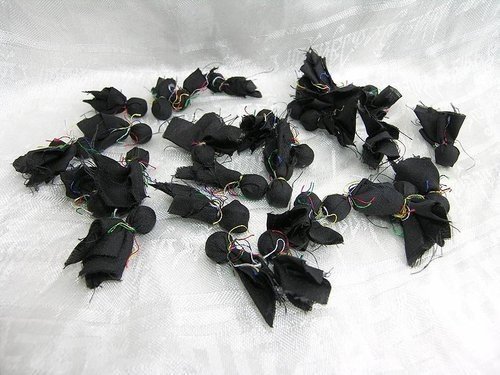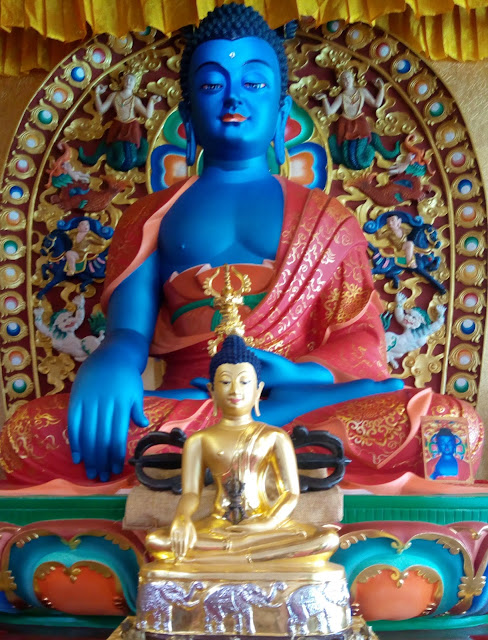So it's extremely powerful. And you should practice it at all times continually. If you really focus on the Seven-Line Prayer, then it is certain that the blessings will come. The blessings of Guru Rinpoche will spring out and be born in your mind stream.
A journey to a mysterious Himalaya snow land and it's unique Vajrayana Buddhism and the threatening culture.
Saturday, August 28, 2021
The King Of Prayers-Seven Line Prayer To Guru Rinpoche
Sunday, August 8, 2021
Ushnishavijaya Dharani in Sanskrit/梵文佛頂尊勝陀羅尼經
The purpose of this sutra is said to be to help sentient beings in a troubled and tumultuous world. According to this sutra, beings will leave suffering and obtain happiness, increasing in their prosperity and longevity, remove karmic obstacles, eliminate disasters and calamities, remove enmity and hatred, fulfill all wishes, and quickly be led into the Buddha's way.
It is held by some that when the Dharani is heard, it can imbue the Alaya consciousness with pure seeds that will help to lead one to Buddhahood. This mantra is also linked to Green Tara.
According to the text, major applications of this Dharaṇi include:1) Destroy calamities and rescue those in difficulties
2) Eliminate offenses and create good deeds
3) Purify all karmic obstructions
4) Increase blessings and lengthen lifespan
5) Attain anuttara-samyak-saṃbodhi
6) Relieve beings in the ghost realm
7) Benefit birds, animals and all crawling creatures
8) Increase wisdom
9) Revert the fixed karma
10) Eliminate various illness
11) Ensure the safety of the households, and having children to inherit the family pride
12) Harmonise husbands and wives
13) Be able to reborn in Sukhavati or other pure lands
14) Heal sickness inflicted by pretas
15) Request for rain
16) Destroy hells
If someone hears this Dharani even just for a moment, he will not undergo karmic retribution from evil karma and severe hindrances accumulated from thousands of kalpas ago, that would otherwise cause him to revolve in the cycles of birth and death - in all kinds of life forms in the evil paths.Hell, hungry ghost, animal, realm of King Yama, Asuras, ferocious animals, crawling creatures and even ants and other life forms...he will be reborn in the Buddhalands, together with all the Buddhas and Ekajati-pratibadda Bodhisattvas, or in a distinguished Brahmin or Ksatriya family, or in some other wealthy and reputable families.
Ushnishavijaya Dharani in Sanskrit:
Namo bhagavate trailokya prativiśiṣṭaya buddhāya bhagavate.
Tadyathā, om, viśodhaya viśodhaya, samâsama
Samantāvabhāsa-spharaṇa gati gahana svabhāva viśuddhe,
Abhiṣiñcatu mām. sugata vara vacana amṛtâbhiṣekai.
Ahara āhara āyuḥ saṃ-dhāraṇi. śodhaya śodhaya gagana viśuddhe.
Uṣṇīṣa vijaya viśuddhe sahasra-raśmi sam-codite.
Sarva tathāgatâdhiṣṭhānādhiṣṭhita mahā-mudre.
Vajra kāya sam-hatana viśuddhe.
Sarvāvaraṇâpāyanagati pariviśuddhe, prati-nivartaya āyuḥ śuddhe.
Samayâdhiṣṭhite. maṇi maṇi mahāmaṇi.
Tathatā bhūta-koṭi pariśuddhe. visphuṭa buddhi śuddhe.
Jaya jaya, vijaya vijaya. smara smara, sarva buddhâdhiṣṭhita śuddhe,
Vajri vajra garbhe vajram bhavatu mama śarīram.
Sarva sattvānām ca kāya pariviśuddhe. sarva gati pariśuddhe.
Sarva tathāgata samāśvāsâdhiṣṭhite.
Budhya budhya, bodhaya bodhaya, śuddhe.
Friday, August 6, 2021
西藏預防傳染病之藏藥 - 九味黑藥丸
 佩戴嗅聞預防傳染病之藏藥一九味黑藥丸可預防各類傳染病,亦可降魔驅邪護身,能夠有效地避免邪魔所造成的障礙。佩戴嗅聞黑藥丸主要是利用藥物的揮發性氣味和藥力,激發 人體的免疫力和調節機制,並在人體外部對傳染病和邪魔病障作預防。
佩戴嗅聞預防傳染病之藏藥一九味黑藥丸可預防各類傳染病,亦可降魔驅邪護身,能夠有效地避免邪魔所造成的障礙。佩戴嗅聞黑藥丸主要是利用藥物的揮發性氣味和藥力,激發 人體的免疫力和調節機制,並在人體外部對傳染病和邪魔病障作預防。 本品是由八蚌寺佛教大學傳統製造工藝處秉承古代傳統藥方,根據西藏古老的 《四部醫典》第四章的內容醫藥實踐方法精心製作而成。 傳染病,即人、畜之間輾轉相傳的流行性瘟毒、疫窩。通常由顯而易 見的感冒症狀開始,迅速發展成為危及生命的惡毒性瘟疫,臨床表現不一。
在西藏的《四部醫典》裏,特別強調預防對於傳染病和邪魔病障造成的病痛 的重要性,更加明確地指出,流行性瘟疫憑藉呼吸、日光、氣味等,由外在 環境入侵體內,因此,提前預防為首要的任务。 預防可透過諸如藥物、咒語、 禪定等外在的方法,相互結合使用,從而起到避免疾病產生的作用。(邪魔病障指由天龍凶曜及妖魔等非人所致病害,如区曜中風和麻瘋病等。) 使用方法: 1、黑藥丸囊為佩戴使用,密封處請勿打開。在傳染病流行期間,或人群聚 集處,可將黑藥丸置入囊中,佩戴於頸項,亦可將藥囊放入貼身衣袋中,隨身攜帶。 2、必要時可打開藥囊,嗅間黑藥丸氣味;或將黑藥丸搗碎用火點燃然,以鼻孔吸取煙味。 特別注意:嚴禁口服。
Monday, August 2, 2021
Prayer To Lord King Gesar 格薩爾王祈禱文
Tuesday, October 10, 2017
What Changed Tibet Today
- In 2006 -2007 Tibet received 7 million tourists, including 1 million foreigners. Tibet has generated a tourism income of 2.29 billion Chinese yuan.
- In 2010, Tibet received 6.85 million tourists from home and abroad, generating revenues of 7.14 billion yuan, 14 percent of its total GDP.
- In 2011 -2012 Tibet received 19 million domestic and foreign tourists.
- In 2015 Tibet received more than 20 million domestic and foreign tourists.
- In first half of 2016 Tibet received a record of 6.8 million tourists domestic and foreign tourists. Tourism revenue during the period increased by 32.1 percent year on year to 7 billion yuan ($1.05 billion), according to a statement issued by the regional tourism development commission.
Sunday, October 8, 2017
The immovable one - Akshobhya Buddha 阿閦如来
Tuesday, May 9, 2017
Saga Dawa Duchen And The Vesak Day
- South Korea Buddhas Birthday - May 3rd
- Macau Buddha's Birthday - May 3rd
- Taiwan Buddha's Birthday - May 3rd
- India Buddha Purnima - May 10th
- Bangladesh Buddha Purnima - May 10th
- Thailand Visakha Bucha Day - May 10th
- Malaysia Wesak Day - May 10th
- Singapore Vesak Day - May 10th
- Cambodia Visak Bochea Day - May 10th
- Sri Lanka Vesak Poya - May 10th
- Myanmar Kasong - May 10th
- Indonesia Waisak Day - May 11th
- Bhutan Saga Dawa Duchen - June 09th
- Tibet Saga Dawa Duchen - June 09th
Amithabha Buddha Prayer Day
"If you wish to come and be born in my realm, you must always recite my sacred mantra again and again, you must always keep this thought in mind without letting up, and thus you will succeed in coming to be born in my realm.
If my 48 Great Vows do not come to pass, may I not attain my enlightenment".
Amitabha Buddha 48 Great Vows
The Tibetan word of "Dewachen" literally means the celestial mandala or the Amithabha Buddha pure land, and in Sanskrit name is Sukhavati and in Chinese is 西方極樂淨土. The Sacred Pure Land of Amitabha Buddha was delivered by Shakyamuni Buddha at the Vulture Peak in Rajagriha, India.
Amithabha Buddha 南無阿彌陀佛 he is represents the Padma Lotus family. Amitābha means "Infinite Light" so Amitābha is also called "The Buddha of Immeasurable Life and Light".
He is the Buddha of the West direction.
His Mantra is " OM AMI DEVA HRIH "
His Mantra in Chinese is " 南無阿彌陀佛 "
His syllable is "Hrih"
His color is in red.
His element is signifies or represents fire
His symbolism is the Lotus.
His wisdom is signifies as Inquisitive and the wisdom of observation.
His hands mudras are signify as Meditation.
He is symbolizes or associated with summer season.
His consort is Pandara.
Sojong Practices ( Eight Mahayana Precepts Practice)
"Jong" means harmful deeds as the Tathagata has taught the practice of Sojong.
Sojong is the Tibetan language and it's also known as the 八關齋戒 or the Eight precepts by the Mahayana practitioners.
The observance of the Eight Precepts or Sojong Practices:-
1-To refrain from killing.
2-To refrain from stealing.
3-To refrain from sexual misconduct.
4-To refrain from lying and intoxication.
5-To refrain from taking a high or luxurious seat.
6-To refrain from singing and dancing.
7-To refrain from wearing ornaments.
8-To refrain from eating after midday.
Thank you for reading, may you find peace and great bliss. With your support it helps to spread the Buddha’s precious teachings and turning the Dharma wheels in the world.
Aspiration For Bodhichitta
For those in whom the precious Bodhichitta has not arisen
May it arise and not decrease
But increase further and further.
Dedication of Merit
By this merit may we obtain omniscience then.
Having defeated the enemies wrong-doings.
May we liberate migratory from the ocean of existence.
With its stormy waves of birth, old age, sickness and death.
*Note
I do not own or infringe any copyright of the picture(s).
Picture(s) courtesy and credit to the rightful distributors and or studios.
Picture(s) is/are intended for editorial use only.












































